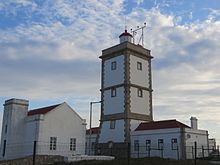Lighthouse of Cabo Carvoeiro
 Cabo Carvoeiro in 2015 | |
 | |
| Location | Peniche, Peniche |
|---|---|
| Coordinates | 39°21′38.4″N 9°24′28.1″W / 39.360667°N 9.407806°W |
| Tower | |
| Constructed | 1893 |
| Construction | 1-story stone lighthouse |
| Height | 27 feet (8.2 m) |
| Shape | square tower |
| Markings | white tower with cornerstones |
| Power source | mains electricity |
| Operator | Directorate for Lighthouses (Direcção de Faróis) |
| Heritage | Unclassified |
| Light | |
| Focal height | 57 feet (17 m) |
| Lens | 3rd order Fresnel lens |
| Range | 13 nautical miles (24 km; 15 mi) |
| Characteristic | Fl.R period 6s, fl. 2s, ec. 4s |
| Portugal no. | PT-143 |
The Lighthouse of Cabo Carvoeiro (Portuguese: Farol do Cabo Carvoeiro) is an active lighthouse in the civil parish of Peniche, municipality of the same name, in the Portuguese district of Leiria.
History
On 1 February 1758, the lighthouse was ordered constructed by regal charter.[1] Cabo Carvoeiro is a prominent cape along the southern Portuguese coast, with a coastal beacon operating for four centuries from the promontory, first from the chapel of Nossa Senhora de Vitória (before it was demolished).[1]
The first purpose-built structure was a 21 metres (69 ft) tall lighthouse that started to operate in 1790, but identified as inadequate by an 1881 commission.[1] In 1865, the lighthouse was described in this form:
- ...it is found at an elevation of 55.52 metres. The light is white and fixed, produced by sixteen Argand with parabolic reflectors. The range exceeds about 9 miles. The lantern where this mechanism was installed has a 8.24 metre height and eight faces with a width of 1.67 metre...The building where the lantern is a rectangular tower, is constructed of masonry with cornerstones. Alongside the tower are lodgings for lighthouse keepers, offices and pantries e, linking theses buildings is a church in ruins (called the Church of Nossa Senhora da Vitória, over which there used to be a light, to guide navigators before the lighthouse existed). The power source was olive oil. [1]
But, by 1886, it was completely remodelled, under the direction and project of Polycarpo Lima. This included the installation of a petrol lamp to illuminate the beacon.[1]
In 1923 the fixture was substituted for a giant fourth-order optical lens, and operated by clockwork mechanical system, resulting in a system of four red flashes, separated in 10 seconds intervals.[1]
The light was substituted in 1947 by gas lamp.[1] Between 1947 and 1949, the Comissão Administrativa das Novas Instalações para a Marinha (Navy New Installations Administrative Commission), later the Direcção de Faróis (Directorate for Lighthouses) constructed the lighthouse keepers residences.[1]
By 1952, the beacon began to operate by electricity.[1]
The lighthouse required large modifications by 1981, in order to receive a new lens, as indicated by reports of the Comissão de Faróis e Balizas (Lighthouse and Beacons Commission).[1] The General Plan projected had a white third-order light that could illuminate a 315º range and support a 17 miles (27 km) range.[1] A red beacon was substituted when the lighthouse along Cabo Mondego was not changed, maintaining a fixed white lamp, then groups of two clarions.[1] By 1988, the lighthouse was automated, with the optics removed and its place replaced by a PRB46 rotating panel, that emitted three, red flashes, with 15 second interval and 15 nautical miles (28 km) range.[1] Its contemporary role is much less important, with the red beacon being used to guide ships on their approach to the nearby fishing port of Peniche.[1]
Architecture
Building constructed to assist maritime navigation that included a permanent residence for the lighthouse keeper, the lighthouse is situated 3 kilometres (1.9 mi) from the Peniche waterfront over a promontory.
The 27 metres (89 ft) high square tower is constructed with cornerstones and parapets painted in white, alongside a rectangular annex building. The tower with lantern and gallery rises from the base of a U-shaped one-story keeper's complex. The buildings are painted white with unpainted stone trim, while the lantern is painted red.
The illumination system consists of a rotating optical lens over a pedestal, using a white light with 15 nautical miles (28 km) range at 57 metres (187 ft) overall height. There is also a fog horn sounding one 10 second blast every 35 seconds.
See also
References
Notes
- ^ a b c d e f g h i j k l m n Costa, Patrícia; Matias, Cecília (2008), SIPA (ed.), FFarol do Cabo Carvoeiro (IPA.00016894/PT031014040027) (in Portuguese), Lisbon, Portugal: SIPA – Sistema de Informação para o Património Arquitectónico, archived from the original on 18 August 2016, retrieved 27 July 2016
Sources
- Relatório da Actividade do Ministério no Triénio de 1947 a 1949 (in Portuguese), Lisbon, Portugal: Ministério das Obras Públicas, 1950
- Callixto, Carlos (1 February 1980), "A Igreja, o Forte e o Farol do Cabo Carvoeiro", Revista da Marinha (in Portuguese)
- Vilhena, João Francisco; Louro, Maria Regina (1995), Faróis de Portugal (in Portuguese), Lisbon, Portugal
{{citation}}: CS1 maint: location missing publisher (link)
